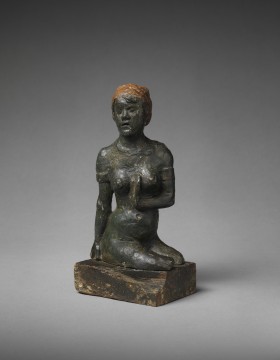Woman of Martinique (Femme de la Martinique)
Provenance
Marie Henry (1859–1945), Le Pouldu, by 1894. [Galerie Zak, Paris, by 1939]; sold to Henry Pearlman, 1 July 1957; Henry and Rose Pearlman Foundation, after 1974.
Critical Perspective
In the spring of 1887, Gauguin set out for Panama, seeking to live in what he imagined to be a simple society. Events did not unfold as he had imagined: after several weeks of forced labor for the Panama Canal Company, he made his way to the French colony of Martinique. Illness brought Gauguin back to France, where he created paintings and ceramics based on his time in the tropics.
This figure is based on women’s faces and headscarves he observed in Martinique. The left arm and hand, however, were inspired by Javanese Buddhist reliefs that Gauguin knew from photographs he purchased in 1889 at the Paris World’s Fair. The sculpture was part of the decor that Gauguin and other artists made for the dining room of their landlady in Brittany, another region that interested them because it seemed "primitive."
The sculpture’s material has historically been identified as terracotta, but recent analysis revealed a metal armature inside. It must, therefore, have been constructed of clay that was unfired and allowed to dry naturally, perhaps to seem more archaic.

